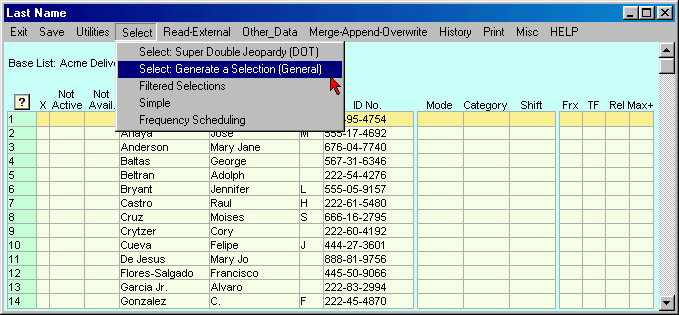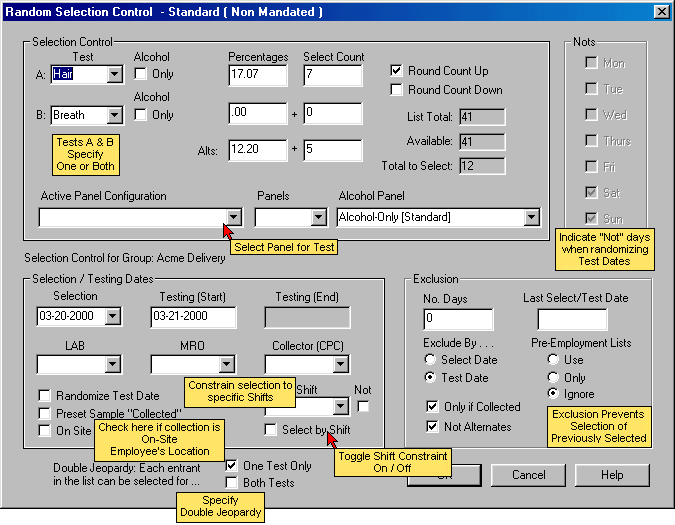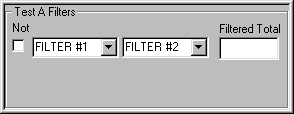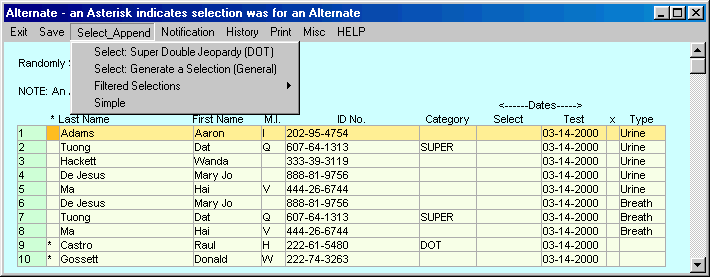General Random Selection Control
| Randomware provides three random selection controls, two of which feature filtering. |
|
| How random selections are generated: Technical Information |
To generate Standard Selections, open a Base List, and choose the menu option, Generate a Selection (General), from the Select menu as shown below.
The general selection control provides the greatest flexibility for random selection. Super Double Jeopardy is used to control testing as efficiently as possible to help minimize the cost of testing.

Random Selection Control: Enter the selection criteria for one or two tests in this selection control box. If you want to select for one test only, use Test-A and simply leave the selection controls for Test-B blank.

| Highlighted Captions | Descriptions |
| Specify selection for one or two tests. Mandated programs often require testing for drugs and alcohol, however, if your application requires only one test type, leave the selection controls for the second test blank. If only one test is specified, the second is simply ignored. | |
| Select the drug "panel configuration" intended for the test. A specific alcohol "panel" can be selected for alcohol only testing. Alcohol panels simply allow for specific alcohol level quantification if test proves positive. The specific panels defined in the configuration will display in the adjoining box under the Panels heading. | |
| Specific days of the week can be excluded if the option to randomize the test date is selected. | |
| Indicate if collection is on-site at the donor's location. | |
| The selection can be constrained to a specific shift if the base list contains multiple shifts, however, it is recommended that lists for different shifts be maintained to accurately track year to date selection and collection percentages. | |
| The selection will not be constrained by shift unless this option is selected, regardless if a shift has been indicated from the selection described above. | |
| Employees previously selected or previously tested can be excluded from the selection by indicating the last selection date or a number of days since last selected or tested. Pre-Employment lists can be used for exclusion if employees were tested prior to employment within a specified number of days. For details see Exclusions. |
| Double Jeopardy controls whether an entry from the list is eligible for selection for both tests if two tests are specified. Consider the example: John Doe is selected for Test-A. | |
| Selected | John Doe will not be excluded for the draw for Test-B. |
| Not Selected | John Doe is not eligible for selection for Test-B. |
| Other Selection Parameters | Description |
| Percentages/Select Counts |
Enter a percentage for each test, the specific count is calculated. Enter a specific count to select and the percentage is calculated. |
| List Total |
The List Total is the number of entrants in the list eligible for selection. This number is the the difference of the absolute count of entrants less those specified as "Not Active." Some applications of Randomware need to maintain accurate employee records. Instead of deleting an entry from the base list when personnel terminate employment, simply check the "Not Active" field. Entrants flagged as "Not Active" do not accumulate to the overall numbers used to calculate year to date percentages. |
| Available |
If an entrant is not available for the specified testing schedule, simply flag the entry as "Not Available." Examples: vacation, jury duty, time off for disability, etc. These entrants still contribute to the overall number counts for year to date percentage calculations. |
| Total to Select |
The sum of selections for tests to be administered, including alternates. |
| Selection Date |
The date the selection was generated. |
| Testing Date (Start) Testing Date (End) |
Testing or collection date. If the option to randomize the test or collection date is selected, then a randomly selected day within the period specified is generated, excluding days specified in the Nots section of the control. |
| Lab |
Preset the Lab which will process the sample. |
| MRO |
Preset the MRO (Medical Review Officer) who will review the documents. |
| Collector | Preset the CPC (Certified Professional Collector) will be gather the samples. |
Preset Sample Collected |
Year to date percentages are usually based on the number of donor samples actually collected. Typically, the number of "No Shows" is less than those who are tested. Pre-specification of collected samples reduces the overhead of post testing data entry. If the sample is preset as "Collected" then data management is reduced to logging the account of those selected who were not tested. |
| Exclusion | |||
| No. Days | Enter the number of days in which individuals previously selected or tested can be excluded from the current selection. Specify "Previously Selected" or "Previously Tested" in the option detailed below. If a pre-employment testing roster is maintain, some companies may choose to exclude newly hired personnel from redundant testing within a number of days since hiring. | ||
| Last Select Date | If "No. Days" is specified as detailed above, then the corresponding calendar date is displayed here. If a Last Select or Testing Date is entered, then "No. Days" is determined and displayed. One will determine the other when specified. | ||
| Exclude By . . . Select Date Test Date |
Excluding by selection date prevents the selection of anyone previously selected within the specified time period. Alternately, personnel may be excluded from subsequent selection if the individual was previously tested within the specified period. The term "Testing" is used equivalently to "Donor Sample Collected." | ||
| Only if Collected Not Alternates |
If exclusion by Select Date is specified, you may choose to exclude individuals if and only if a sample was actually collected. Furthermore, if exclusion by Select Date is specified, it may be essential NOT to exclude those previously selected as alternates. There are myriad exclusion possibilities and they all depend on how individual applications of Randomware mange their selection history data. | ||
|
Pre-Employment
can be used to determine exclusion.
Use: Check pre-employment list for personnel tested within the specified number of days. If the date of testing, for a name found in a pre-employment list, is within the specified number of days, the entry will be excluded from the current selection. Only: Exclusion testing is applied only to pre-employment lists. Selection history data is not reviewed to determine is base list entries are excluded from the possibility of selection, i.e., if someone was previously tested within the specified no. of days, but not through pre-employment, then that person is eligible for selection. Ignore: Pre-Employment lists will not be reviewed to determine exclusion, i.e., an individual will not be excluded from selection regardless of pre-employment testing. All pre-employment lists are reviewed. A master pre-employment list can be maintained for an entire directory and individually for each group within the directory. |
Test Types
 |
The first two fields (Filter #1 & Filter #2) in the Test A/B Filter areas allow you to specify categories by which to filter the current base list. The categories listed in these two drop down selection controls are those found in the base list from which the selection will be generated. |
For example, if you select two categories in the Test A filter boxes, then an individual is eligible for random selection if and only if his or her category matches Filter #1 or Filter #2.
If you check the Not box then those entries whose category is Not Filter #1 and Not Filter #2 will be eligible for random selection.
Possible Minimum Available
It is possible to enter filters that have overlapping categories.
If
double jeopardy is not selected then an entrant who has been selected for Test-A, will not
be considered for selection for Test-B. The program displays the number of
entrants available for Test-B after considering the selection of Test-A.
For a detail discussion of the random selection algorithm see the Random Algorithm page.
Consider the following example:
Consider the example of someone who works for two companies
in the same selection pool.
Henry works for two companies - both in the same
pool and therefore Henry appears in the pooled list twice.
Essentially, Henry is treated as two separate individuals as far as the program is
concerned and is twice as likely to be selected as someone who appears in the list only
once. Consider the two individuals he represents as Henry-A and Henry-B.
Double Jeopardy:
Henry-A is the Henry who works for Acme.
Henry-B is the Henry who works for Quick Silver. (Acme & Quick Silver are pooled)
And further, assume Alice, too, works for Acme.
Generate a selection for two tests: breath & urine.
Alice could possibly be selected for both breath & urine.
Henry could possibly be asked to take four tests total:
Henry-A could be selected for both breath & urine - i.e. breath & urine at Acme.
Henry-B could be selected for both breath & urine - i.e. breath & urine at Quick
Silver
Single Jeopardy:
Alice could be selected for either breath or urine - not both
Henry-A could be selected for breath or urine - not both (for Acme.)
Henry-B could be selected for breath or urine - not both (for QS.)
The selection possibilities for Henry are:
A breath at Acme and a breath at Quick Silver.
A breath at Acme and a urine at QS.
OR...
A urine at Acme and a breath at QS.
A urine at Acme and a urine at QS.
Selection Results & Building Selection Lists Incrementally: Subsequent selections can be made from the names remaining in the original list. The subsequent selections will append to the end of the currently displayed selection list. The same selection controls are available from the selection results window as those used to generate the initial selection.

This completes the random selection process.
Printing the Selection List
Pooled Selections: Selections from each company
print separately - employees in alphabetical order. The alternates print on
a separate page in the order they were selected.
Non-Pooled Selections: The list is printed with employees in
alphabetical order while the alternates print at the end of the list in the order
they were selected.
All selections generated are automatically recorded in the audit trail file.
